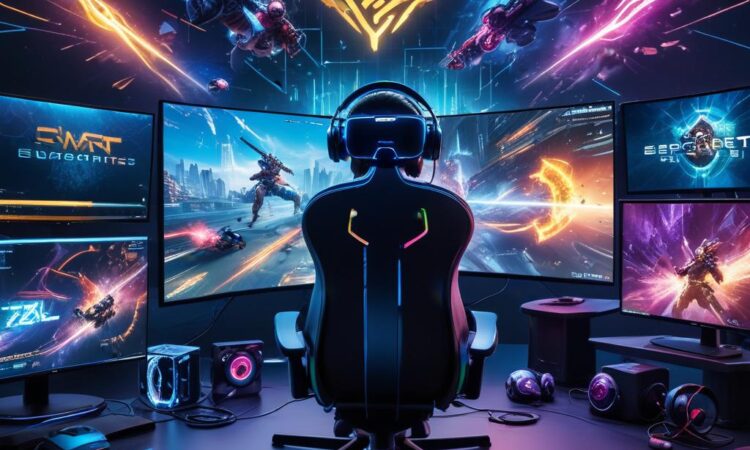Emerging Trends in Esports Tech: Level Up!
Hey esports fanatics! Let’s dive into the wild world of technological advancements shaping the competitive gaming scene. Things are changing FAST, and it’s impacting everything from how we play to how we watch.
New Hardware: The Next-Gen Advantage
Forget your grandpa’s gaming rig. Today’s top esports athletes are demanding – and getting – seriously powerful hardware. We’re talking about processors that can handle insane frame rates, graphics cards that render detail like you’re *in* the game, and super-fast RAM to keep everything running smooth as butter. This isn’t just about better visuals; lower latency (that lag you hate) is a massive advantage in competitive play. A single millisecond can be the difference between victory and defeat. The jump to higher refresh rate monitors is also huge – making everything feel incredibly responsive and giving players a clearer picture of what’s happening on screen.
We’re also seeing specialized peripherals popping up all the time. Customizable mice, keyboards with lightning-fast response times, and even haptic feedback suits are pushing the boundaries of player interaction and performance. These are more than just fancy gadgets; they are tools that help pros gain a competitive edge. Think of it as the difference between a sharp chef’s knife and a dull butter knife – you need the right tools to truly excel.
Software Savvy: Beyond the Game
The hardware is only half the battle. Software is playing an increasingly crucial role. Advanced game analysis tools are becoming essential for professional teams. These tools allow coaches to meticulously track player performance, identify strengths and weaknesses, and craft winning strategies based on data rather than gut feelings. Think of it as advanced sports analytics, but for esports.
Beyond team analysis, we’re seeing improvements in streaming and broadcasting software. This results in higher quality streams for viewers, more engaging broadcasts, and improved accessibility for fans around the globe. This technological progress ensures that even fans thousands of miles away feel part of the action. This also means better overlay systems during live events, easier integration of sponsorships, and smoother transition during tournaments and matches.
Game Engines: The Foundation of Awesome
At the heart of it all are the game engines themselves. Constant updates and improvements to engines like Unreal Engine and Unity are driving stunning graphics and enhanced gameplay mechanics. New physics engines create more realistic and dynamic in-game environments, while improved networking tech allows for smoother online multiplayer experiences. These advancements directly influence the competitive landscape, creating new opportunities for tactical gameplay and strategic thinking.
Think about the evolution of fighting games. The precision of movement and the responsiveness of the game engines have improved immensely, directly impacting the complexity and skill ceiling of competitive play. It’s no longer just about button mashing – it’s about precise timing, spatial awareness, and a deep understanding of the game’s mechanics. These game engine improvements are the backbone of this level of intricate play.
The Impact on the Competitive Landscape
All these technological advancements have a profound impact on the esports competitive landscape. Teams with access to the latest technology and the expertise to utilize it effectively gain a clear advantage. This creates a dynamic and ever-evolving competitive scene where innovation is key to staying ahead of the curve. The barrier to entry for professional play is getting higher, demanding constant adaptation and upgrading.
However, this also leads to increased parity in some ways. Better analysis tools mean that even smaller teams have the chance to compete with established giants, if they know how to use the tools available. This focus on data and analysis means that raw talent alone is no longer enough – players also need to understand strategies and adapt their gameplay based on data insights.
The Player Experience: Immersion and Beyond
The improvements aren’t just about professional play. The player experience is being dramatically enhanced across the board. Better graphics, improved performance, and more immersive gameplay mean that gaming is becoming increasingly engaging and enjoyable for everyone, not just professional players. The line between reality and the virtual world is blurring, creating a truly compelling experience.
VR and AR technologies are also starting to make a mark, offering entirely new ways to interact with games and compete. Imagine playing a first-person shooter where you actually feel the recoil of the weapon or experiencing a racing game with lifelike driving sensations. These technologies are still early days, but their potential to revolutionize esports is immense.
In short, the future of esports is being shaped by rapid technological advancement. It’s an exciting time to be a player, a spectator, or even just a fan of this constantly evolving world of competitive gaming. The journey towards even more impressive and immersive experiences is far from over.

